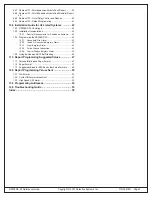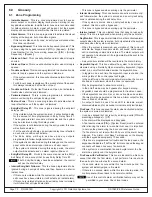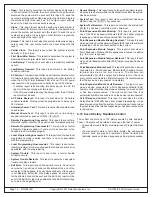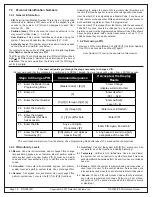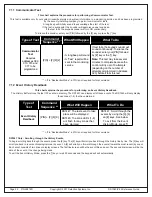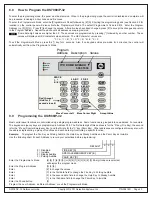
DS7080iP-32 Reference Guide Copyright © 2001 Detection Systems, Inc. P/N 39818D Page 11
• Interior Delay: This interior zone follows Entry Delay Time #1.
• Perimeter Homeguard: This zone type is active when the panel
is armed. When the panel is armed perimeter only, this is a delayed
zone. When armed full, this is an instant zone. The Perimeter
Homeguard follows Entry Delay Time #1.
• Perimeter Follower Homeguard: These zones are always
delayed when the panel is armed in the perimeter only mode.
When the panel is fully armed, these zones are delayed if a
delayed zone is violated first, or instant if this zone or an instant
zone is violated first. The Perimeter Follower Homeguard follows
Entry Delay Time #1.
6.2
Output Programming
• Latch ON Any Burglar Alarm: This is an output programmed to
activate upon any zone alarm (including invisible and silent zones).
It will latch until the system has been disarmed.
• ON during Entry Pre-Alert: This is an output programmed to
activate when an entry/exit zone is violated while the system is
armed. It will remain activated until the system is disarmed, or
until the entry delay time has expired.
• On for 8 seconds after [PIN] + [System Reset] is entered:
This is an output programmed to activate only for 8 seconds after
[PIN] + [System Reset] is entered at a keypad or if a fire zone with
verification activates.
- This output is intended to be used to power 4-wire smoke de-
tectors or any other device that requires a power interruption to
reset an alarm condition.
When Programmable Output 2 is programmed this way, it
will normally supply auxiliary power and will turn OFF for 8
seconds when [PIN] + [System Reset] is entered.
• ON when System is Armed: This is an output programmed to
activate when the entire system is armed. If the system is
partitioned, both partitions must be armed to get this output. It will
remain activated until the system (or one of the partitions) is
disarmed.
• Ground Start: This is an output programmed to activate for 3
seconds when the phone line is seized. It is intended for use with
ground start phone systems that require a momentary short to
ground to obtain a dial tone.
- Connect a separate 12 VDC, DPDT relay. Connect both relay
commons to ground, and connect the Normally Open contact
of each to Terminals 27 and 30 (one to Terminal 27, one to
Terminal 30) of the DS7080iP-32.
- Not to be used in UL Listed systems.
- Not for use with phone line monitors.
• System Status (ready to arm): This is an output programmed to
follow the Status Light of the keypad. It will activate when the
system is ready to arm with no zones violated.
• Burglar Zone: This is an output programmed to activate when a
Burgular Zone is in an alarm condition. It will remain activated
until the system is disarmed or the bell cut-off time expires.
- This output is intended to activate bells and sirens.
- This will not activate from Silent or Invisible zones.
• Burglar Zone Delayed by 20 seconds: This is an output
programmed to wait 20 seconds after the zone enters an alarm
condition to activate. It will remain activated until the system is
disarmed or the bell cut-off time expires.
- This output is intended to activate alarm bells and sirens, but
provides a delay to allow the user to silence the system before
it activates.
• Fire Zone: This is an output programmed to activate when a Fire
Zone is in an alarm condition. It will remain activated until the
system is disarmed, reset or the bell cut-off time expires.
• Fire Zone Delayed by 20 seconds: This is an output programmed
to wait 20 seconds after the zone enters an alarm condition to
activate. It will remain activated until the system is disarmed, reset
or the bell cut-off time expires.
This Feature may not be allowed in your area. Check your
local codes.
• Keypad Sounder Output: This is an output programmed to follow
the keypad sounder. It activates during the entry pre-alert, chime
mode and during any day monitor alarm.
- It does not follow momentary keypad beeps such as keystrokes.
• Access Output: This is an output programmed to activate for 10
seconds when an access control [PIN] + [Off] is entered at the
keypad.
- Not UL Listed for Access Control (UL294).
• Pulsing Fire Zone: This is an output programmed to pulse for a
fire alarm (one second ON, one second OFF).
• California March Time: This is an output programmed to pulse
for a fire alarm in the California Time cadence (ten 1/2 second
pulses, followed by one second of quiet time).
• Temporal: This is an output programmed to pulse for a fire alarm
in the Temporal cadence (three 1/2 second pulses, followed by
one second of quiet time).
6.3
General Control Programming
• Normal Arming - [PIN] + [On]: This command arms the entire
system while allowing for entry/exit delays. It appears in the history
as level 1.
• Perimeter Instant Arming - [PIN] + [No Entry] + [Perimeter
Only]: If programmed, this command arms only the perimeter of
the system and does not allow entry delays for entry/exit zones.
It appears in the history as level 2.
• Perimeter Arming - [PIN] + [Perimeter Only]: If programmed,
this command arms only the perimeter of the system while allowing
for entry/exit delays. It appears in the history as level 3.
• Custom Arming - [PIN] + [#] [4]: If programmed, this command
allows custom arming of the system and bypasses specified zones.
Users with authority to two partitions cannot custom arm a single
partition. It appears in the history as level 4.
• Maximum Security Arming - [PIN] + [No Entry] [On]: If
programmed, this command arms the entire system and does
not allow entry delays for entry/exit zones. It appears in the history
as level 5.
• Level 6 Arming: This is the report left in the history buffer that
shows that the system has been force armed. It appears in the
history as level 6.
• Closing Ring-Back: If programmed, the keypad sounders and
Bell will activate for 2 seconds after the system is armed and the
closing report is successfully sent. This requires Closing Ring-
Back and Closing Report to be programmed.
- If a closing report is not programmed, the control will test for a
dial tone when the system is armed. If the test passes, the
system will arm normally. If the test fails, the system will arm,
but will indicate a trouble condition.
- This can also be used to perform a Bell test upon Arming.



